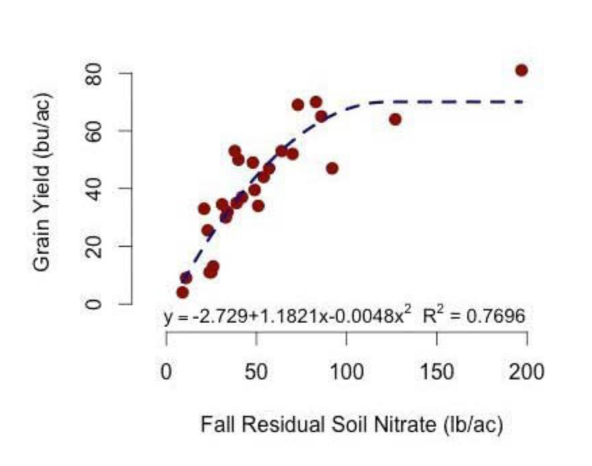
By STACY CAMPBELL
Cottonwood Extension District
For many years, taking 24-inch soil profile-N samples in the fall has been a recommended practice for making an N recommendation for winter wheat. However, due to the mobility of nitrate-N in the soil, soil test values observed in the fall may differ from those observed in the spring, particularly on soils prone to leaching.
Because many producers wait until spring green-up to make their N application, does soil sampling in the fall for nitrate really provide useful information for N management in wheat? That is a legitimate question.
What Research Shows
In K-State trials where no N fertilizer was applied, there was a strong positive relationship between fall nitrate-N levels and final wheat yield (Figure 1).

When fall nitrate-N levels were low, wheat yields responded well to fertilizer. When nitrate-N levels exceeded 80–100 lb./acre, additional spring-applied N rarely increased yield. In short, fall nitrate-N levels are a reliable predictor of whether or not a crop will benefit from additional N fertilizer. This makes soil sampling in the fall an important tool for maximizing yield and efficiency.
When soil sampling for N is not done, the K-State fertilizer recommendation formula defaults to a standard value of 30 lb/acre available N.
In this particular dataset, the average profile N level was 39 lb N/acre. However, the N level at individual sites ranged from 11 to 197 lbs N/acre. Most recommendation systems default to a standardized set of N recommendations based on the yield goal and/or the cost of N.
In Summary
Without soil sampling or some other method of estimating available N, such as crop sensing, N recommendations will be inaccurate. Failure to account for the N present in the soil wastes a valuable resource. It can result in excess foliage, increased plant disease, inefficient use of soil water, and reduced yield.
Fall soil profile testing for nitrate-N continues to play a valuable role in efficient N management for winter wheat in Kansas. It’s a cost-effective way to fine-tune your fertilizer program, avoid unnecessary inputs, and protect both yield and the environment.
While on the subject of wheat, I hope you can join us Wednesday, August 20 for a “Pre-plant Wheat School” in Great Bend at the Event Center, 3111 10th Street. Registration and supper begin at 5:30 p.m. To ensure a meal pre-registration is requested by calling 785-628-9430 email me [email protected] or scan the QR code below.

Stacy Campbell is a Crop Production Extension agent in the Cottonwood District (which includes Barton and Ellis counties) for K-State Research and Extension. You can contact him by e-mail at [email protected] or by calling 785-628-9430.






